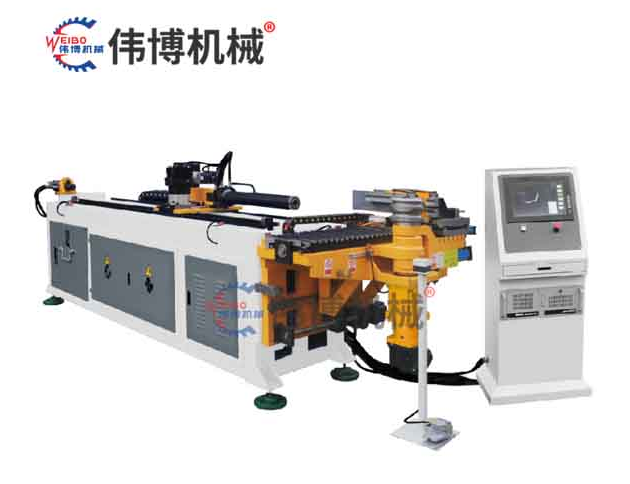The pipe bender makes mistakes when bending the pipe, so how to eliminate the work error of the pipe bender? From the derivation formula of the error caused by the differential pressure transmitter, it can be seen that the primary reason is the existence of the height difference in the differential pressure calculation, that is, H≠0. In order to eliminate the existence of H, the two pressure points of the elbow sensor are required to be in the same horizontal plane. That is to say, in principle, the horizontal layout plan may be used. However, when the horizontal plan cannot be used, the length of the differential pressure pipeline should be shortened and the online real-time compensation plan should be adopted. After discussing the formula of the curvature radius ratio caused by thermal expansion, it can be seen that: When L1=L2, the violation length Z of R′ and R is small, that is, it is required to make the lengths of the straight pipes on both sides of the elbow as flat as possible. In addition, in order to reduce the stress concentration of the pipeline extension at the elbow flowmeter, the method of diverting the elongation can be adopted, that is, expansion joints or expansion joints are separately installed on both sides of the elbow flowmeter beyond the length required by the elbow flowmeter device. Considering the π-type device method, the fluid flowing through the elbow will undergo centripetal acceleration due to the effect of the centripetal force exerted by the pipe wall, forming an overall spatial rotation movement. (Flow state representation) The intensity of the active centripetal acceleration is characterized by the centripetal acceleration of the fluid, and can be determined by measuring the fluid differential pressure signal inside and outside the elbow. Under the condition that the bend-to-diameter ratio (the degree of tortuosity) of the elbow and the density of the fluid medium are known, the flow rate can be calculated by the formula when the differential pressure between the inner and outer diameters is measured.

The elbow flowmeter uses a 90° standard elbow sensor as the flow sensor, and measures the flow by measuring the differential pressure signal at 45° points inside and outside the sensor. The fluid flow rate is generally determined by the following formula
V=α[(R/D)×ΔP/ρ1)][1/2]
In the formula, V is the uniform flow velocity; α is the flow velocity coefficient; R/D is the bend diameter ratio of the elbow; ρ1 is the fluid density in the pipe; ΔP is the differential pressure signal that causes the centripetal motion of the fluid.
The differential pressure signal ΔP is:
ΔP=ΔP1-ΔP2
ΔP1=P1-P10, ΔP2=P2-P20,
In the formula, ΔP1 is the pressure increment of the fluid at point A on the curved side of the elbow sensor at the 45° point; ΔP2 is the pressure increment of the fluid at the point B on the curved side of the elbow sensor at the 45° point; P1 is A when the fluid moves at the flow velocity V P10 is the static pressure at point A when the fluid is at rest; P2 is the pressure at point B when the fluid moves at the flow velocity V; P20 is the static pressure at point B when the fluid is at rest.
When the fluid is stationary, the static pressure difference between points A and B (P10-P20) is determined by the height difference H between the two points and the density of the fluid. That is: ΔP=P1-P2-ρ1gH
In practice, elbow flowmeters are often used in hot water pipelines and other environments where there is a temperature difference compared to the design conditions. Because the environment changes, there will be errors in the measurement.
Let's first analyze the reasons for the error of the pipe bending machine.
(1) Errors caused by differential pressure transmitters
In the calculation formula of the elbow flowmeter, P is the differential pressure signal of the points on the inner and outer walls of the elbow. At present, various differential pressure transmitters are generally used to measure the differential pressure signal ΔP, and the typical measurement system is shown in Figure 2. The pressure P1 is taken out from point A, the pressure P2 is taken out from point B, and connected to the A' and B' ends of the differential pressure transmitter G through the pressure guiding pipes L1 and L2 respectively, the heights of A and A', B and B' The difference is H and H', and the differential pressure signal ΔP' directly measured by the differential pressure transmitter is:
ΔP'=P'1-P'2=(P'1+H1ρ0g)-(P2+H2ρ0g)
ΔP'=-ΔP+(ρ0-ρ1)gH
In the formula, ρ0 is the density of water in the pressure guiding tube, which is a function of temperature under normal pressure. Under normal temperature conditions, the water temperature in the main pipe and the water temperature in the pressure guiding pipe are the same, that is, they have the same density, that is
ρ0=ρ1
When the water temperature in the main pipe is higher than the ambient temperature, the density of the water in the main pipe and the water in the pressure guiding pipe is different due to the existence of heat conduction.
Experiments show that the water in the pressure guiding tube is mainly conducted by heat radiation, and the temperature of the water in the pressure guiding tube decreases rapidly with the length of the pressure guiding tube. When the length of the conduit reaches a certain length L0, the water temperature and ambient temperature in the conduit are the same, that is, the density does not change after L0. Within the range of L0, ρ0 is a function of temperature and also a function of length.
The above formula shows that the differential pressure signal directly measured by the differential pressure transmitter not only contains the differential pressure signal ΔP that causes the centripetal acceleration motion of the hot water, but also contains the height difference H between the two pressure points and the density of the hot water in the main pipeline. The differential pressure error signal term that occurs due to the difference in water density in the pressure guiding tube.
(2) Curvature error caused by thermal expansion
Because the elbow itself is a flexible element, the thermal elongation of the heating pipe will converge to the elbow, so that the elbow will bend and deform, which will cause the curvature radius of the elbow to be different from the designed curvature radius.
To further understand the occurrence of errors, we calculated the following assumptions based on the actual pipe network system (as shown in Figure 3): (1) Ignoring the resistance of the elbow, that is, the internal force of the elbow resists the bending deformation and reduces the L1 and L2 sections. The elongation is 0; (2) It is assumed that the elbow is still arc-shaped after deformation, and is still tangent to the pipelines on both sides; (3) The L1 and L2 pipelines are treated as rods, and all deformations are within a small deformation range. Let the deformations of L1 and L2 be ΔL1 and ΔL2, respectively. According to the assumed conditions, L1 and L2 can be regarded as cantilever beams with A and B as fixed points, respectively, and the deflections due to temperature changes are YC and YD; ΔL1=ηL1Δt; ΔL2=η2L2Δt;
where η is the linear expansion coefficient of the pipe material
The approximation by the continuity of the pipeline is:
YC=ΔL2; YD=ΔL1
From the geometric relationship, using the common knowledge of material mechanics, the corners of points C and D can be obtained as:
θC=PDL12/2EI; θD=PCL22/2EI
The deflections at points C and D are respectively:
YC=PDL13/3E1; YD=PCL23/3EI
Contact: Manager Ning
Mobile: 15371891344
Email: weibojx@qq.com
Website: www.zjgwbjx.com
Address: Jiangong Avenue, Zhangjiagang City, Suzhou City, Jiangsu Province

【WeChat】